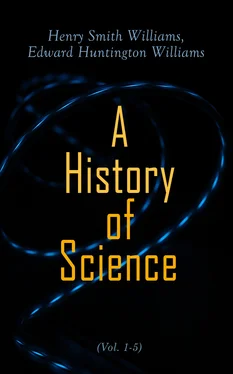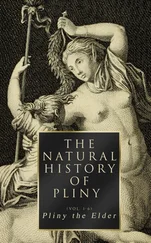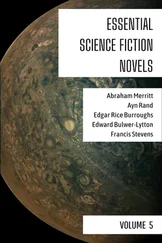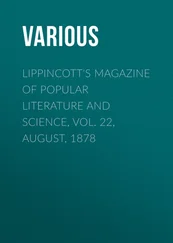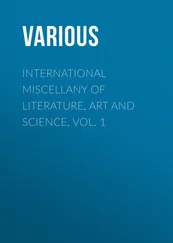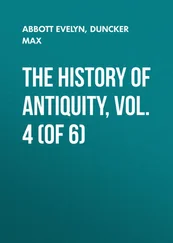The Almagest treats of all manner of astronomical problems, but the feature of it which gained it widest celebrity was perhaps that which has to do with eccentrics and epicycles. This theory was, of course, but an elaboration of the ideas of Hipparchus; but, owing to the celebrity of the expositor, it has come to be spoken of as the theory of Ptolemy. We have sufficiently detailed the theory in speaking of Hipparchus. It should be explained, however, that, with both Hipparchus and Ptolemy, the theory of epicycles would appear to have been held rather as a working hypothesis than as a certainty, so far as the actuality of the minor spheres or epicycles is concerned. That is to say, these astronomers probably did not conceive either the epicycles or the greater spheres as constituting actual solid substances. Subsequent generations, however, put this interpretation upon the theory, conceiving the various spheres as actual crystalline bodies. It is difficult to imagine just how the various epicycles were supposed to revolve without interfering with the major spheres, but perhaps this is no greater difficulty than is presented by the alleged properties of the ether, which physicists of to-day accept as at least a working hypothesis. We shall see later on how firmly the conception of concentric crystalline spheres was held to, and that no real challenge was ever given that theory until the discovery was made that comets have an orbit that must necessarily intersect the spheres of the various planets.
Ptolemy's system of geography in eight books, founded on that of Marinus of Tyre, was scarcely less celebrated throughout the Middle Ages than the Almagest. It contained little, however, that need concern us here, being rather an elaboration of the doctrines to which we have already sufficiently referred. None of Ptolemy's original manuscripts has come down to us, but there is an alleged fifth-century manuscript attributed to Agathadamon of Alexandria which has peculiar interest because it contains a series of twenty-seven elaborately colored maps that are supposed to be derived from maps drawn up by Ptolemy himself. In these maps the sea is colored green, the mountains red or dark yellow, and the land white. Ptolemy assumed that a degree at the equator was 500 stadia instead of 604 stadia in length. We are not informed as to the grounds on which this assumption was made, but it has been suggested that the error was at least partially instrumental in leading to one very curious result. "Taking the parallel of Rhodes," says Donaldson,(5) "he calculated the longitudes from the Fortunate Islands to Cattigara or the west coast of Borneo at 180 degrees, conceiving this to be one-half the circumference of the globe. The real distance is only 125 degrees or 127 degrees, so that his measurement is wrong by one third of the whole, one-sixth for the error in the measurement of a degree and one-sixth for the errors in measuring the distance geometrically. These errors, owing to the authority attributed to the geography of Ptolemy in the Middle Ages, produced a consequence of the greatest importance. They really led to the discovery of America. For the design of Columbus to sail from the west of Europe to the east of Asia was founded on the supposition that the distance was less by one third than it really was." This view is perhaps a trifle fanciful, since there is nothing to suggest that the courage of Columbus would have balked at the greater distance, and since the protests of the sailors, which nearly thwarted his efforts, were made long before the distance as estimated by Ptolemy had been covered; nevertheless it is interesting to recall that the great geographical doctrines, upon which Columbus must chiefly have based his arguments, had been before the world in an authoritative form practically unheeded for more than twelve hundred years, awaiting a champion with courage enough to put them to the test.
GALEN—THE LAST GREAT ALEXANDRIAN
There is one other field of scientific investigation to which we must give brief attention before leaving the antique world. This is the field of physiology and medicine. In considering it we shall have to do with the very last great scientist of the Alexandrian school. This was Claudius Galenus, commonly known as Galen, a man whose fame was destined to eclipse that of all other physicians of antiquity except Hippocrates, and whose doctrines were to have the same force in their field throughout the Middle Ages that the doctrines of Aristotle had for physical science. But before we take up Galen's specific labors, it will be well to inquire briefly as to the state of medical art and science in the Roman world at the time when the last great physician of antiquity came upon the scene.
The Romans, it would appear, had done little in the way of scientific discoveries in the field of medicine, but, nevertheless, with their practicality of mind, they had turned to better account many more of the scientific discoveries of the Greeks than did the discoverers themselves. The practising physicians in early Rome were mostly men of Greek origin, who came to the capital after the overthrow of the Greeks by the Romans. Many of them were slaves, as earning money by either bodily or mental labor was considered beneath the dignity of a Roman citizen. The wealthy Romans, who owned large estates and numerous slaves, were in the habit of purchasing some of these slave doctors, and thus saving medical fees by having them attend to the health of their families.
By the beginning of the Christian era medicine as a profession had sadly degenerated, and in place of a class of physicians who practised medicine along rational or legitimate lines, in the footsteps of the great Hippocrates, there appeared great numbers of "specialists," most of them charlatans, who pretended to possess supernatural insight in the methods of treating certain forms of disease. These physicians rightly earned the contempt of the better class of Romans, and were made the object of many attacks by the satirists of the time. Such specialists travelled about from place to place in much the same manner as the itinerant "Indian doctors" and "lightning tooth-extractors" do to-day. Eye-doctors seem to have been particularly numerous, and these were divided into two classes, eye-surgeons and eye-doctors proper. The eye-surgeon performed such operations as cauterizing for ingrowing eyelashes and operating upon growths about the eyes; while the eye-doctors depended entirely upon salves and lotions. These eye-salves were frequently stamped with the seal of the physician who compounded them, something like two hundred of these seals being still in existence. There were besides these quacks, however, reputable eye-doctors who must have possessed considerable skill in the treatment of certain ophthalmias. Among some Roman surgical instruments discovered at Rheims were found also some drugs employed by ophthalmic surgeons, and an analysis of these show that they contained, among other ingredients, some that are still employed in the treatment of certain affections of the eye.
One of the first steps taken in recognition of the services of physicians was by Julius Caesar, who granted citizenship to all physicians practising in Rome. This was about fifty years before the Christian era, and from that time on there was a gradual improvement in the attitude of the Romans towards the members of the medical profession. As the Romans degenerated from a race of sturdy warriors and became more and more depraved physically, the necessity for physicians made itself more evident. Court physicians, and physicians-in-ordinary, were created by the emperors, as were also city and district physicians. In the year 133 A.D. Hadrian granted immunity from taxes and military service to physicians in recognition of their public services.
The city and district physicians, known as the archiatri populaires, treated and cared for the poor without remuneration, having a position and salary fixed by law and paid them semi-annually. These were honorable positions, and the archiatri were obliged to give instruction in medicine, without pay, to the poor students. They were allowed to receive fees and donations from their patients, but not, however, until the danger from the malady was past. Special laws were enacted to protect them, and any person subjecting them to an insult was liable to a fine "not exceeding one thousand pounds."
Читать дальше
